Timeline of the Mongol Empire
This is the timeline of the Mongol Empire from the birth of Temüjin, later Genghis Khan, to the ascension of Kublai Khan as emperor of the Yuan dynasty in 1271, though the title of Khagan continued to be used by the Yuan rulers into the Northern Yuan dynasty, a far less powerful successor entity, until 1634.
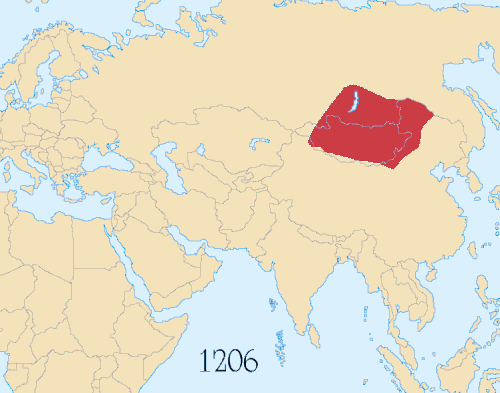
Expansion of the Mongol Empire
12th century
1160s
| Year | Date | Event |
|---|---|---|
| 1162 | Temüjin is born in Delüün Boldog near Burkhan Khaldun to the Mongol chieftain Yesugei and Hoelun[1] |
1170s
| Year | Date | Event |
|---|---|---|
| 1171 | Yesugei takes Temüjin east through Tatar territory to the Khongirad homeland to arrange a future marriage between his son and Börte. Temüjin stays with the Khongirads to learn their ways, however Yesugei is poisoned by the Tatars during his return trip. Temüjin leaves Börte for his father, but arrives too late to see his father alive. His father's followers scatter and Hoelun is left to care for their children by herself.[2] She takes them to the Khentii Mountains, where they live for several years.[3] | |
| 1173 | Temüjin becomes anda, blood brothers, with Jamukha of the Jajirad (Jadaran) clan[4] | |
| 1177 | Temüjin leaves to claim Börte. Börte's father gives him a black sable cloak as dowry, which he later gives to Toghrul of the Keraites to gain his favor. Soon after the Merkits abduct Börte and Temüjin flees. [5] | |
| 1178 | Temüjin assembles an allied force of over 20,000 with his ally Toghrul and sworn blood brother Jamukha, who attack the Merkits and rescue Börte.[3][5] |
1180s
| Year | Date | Event |
|---|---|---|
| 1185 | Mongols gather at Burkhan Khaldun to throw their support behind Temüjin in fear of the rising power of Jamukha[3] | |
| 1187 | Temüjin allies himself with the Khongirad to wage war on the Tatars.[3] |
1190s
| Year | Date | Event |
|---|---|---|
| 1191 | Temüjin, Jamukha, and Toghrul attack the Merkits.[6] | |
| 1192 | Jin dynasty starts constructing fortifications in the northwest to prevent depredations by the Mongols[7] | |
| 1193 | Jamukha refuses to acknowledge Temüjin's leadership and wages war on him.[8] | |
| 1194 | Jamukha and Temüjin clash at the Dalan Baljut, which ends inconclusively. However Jamukha's rash and vindictive behavior towards his allies alienates him.[8] | |
| 1196 | Jin and Mongol troops carry out a punitive expedition against the Tatars[9] |
13th century
1200s
| Year | Date | Event |
|---|---|---|
| 1201 | Mongols opposing Temüjin promote Jamukha to gür-khan[4] | |
| 1202 | Mongols exterminate the Tatars[10] | |
| 1203 | Temüjin splits with Toghrul[11] | |
| spring | The Keraites defeat Temüjin at Qalaqaljid Sands[12] | |
| autumn | Temüjin defeats Toghrul at Jeje'er Heights[12] | |
| Temüjin creates the Kheshig, an elite military guard[13] | ||
| 1204 | Temüjin defeats the Naimans, Merkits, and Jamukha; Merkit leaders and Jamukha flee to the Altai Mountains[13] | |
| fall | Temüjin pursues Jamukha and defeats him in several battles. Eventually Jamukha's allies betray him and turn him over to Temüjin, who kills him by breaking his back.[13] | |
| The Uyghurs and Ongud submit to Temüjin[14] | ||
| 1205 | spring | Mongol conquest of Western Xia: Temüjin of the Mongols raids Western Xia's border settlements[15] |
| 1206 | spring | Kokochu, also known as Teb Tengri, chief shaman of the Mongols, bestows upon Temüjin the title of Genghis Khan, "Universal Ruler" of the Mongol Empire, at the kurultai of Burkhan Khaldun, sacred mountain of the Mongols[16] |
| 1207 | Mongol conquest of Western Xia: Genghis Khan sacks Wulahai, a Western Xia garrison along the Yellow River near modern Wuyuan[17] | |
| Jochi subjugates the 'forest peoples' - Kyrgyz, Oirat, and Buryat[18] | ||
| 1208 | Toq'toa Beki of the Merkits is killed by Mongols and Uyghurs[18] | |
| 1209 | autumn | Mongol conquest of Western Xia: Genghis Khan penetrates Western Xia from Wulahai and defeats a Tangut army before laying siege to Zhongxing, however the Mongols accidentally flood their own camp in the process of breaking the Yellow River dikes and are forced to retreat[19] |
| Qocho, Qayaligh, and Almaliq submit to Genghis Khan; Almaliq and the Issyk-Kul region given to Chagatai[20] |
1210s
| Year | Date | Event |
|---|---|---|
| 1210 | Mongol conquest of Western Xia: Emperor Xiangzong of Western Xia submits to the Mongol Empire and hands over a daughter in marriage to Genghis Khan as well as a large supply of camels, falcons, and woven textiles; a Mongol garrison is left at Wulahai[19] | |
| Kokochu is killed by Qasar in a wrestling match[21] | ||
| 1211 | Mongol conquest of the Jin dynasty: Jochi, Ögedei, and Chagatai invade Inner Mongolia[22] | |
| October | Mongol conquest of the Jin dynasty: Jebe takes Juyong Pass from the Jin dynasty[23] | |
| winter | Mongol conquest of the Jin dynasty: Mongol forces retreat from Jin territory[24] | |
| Karluks rebel against the Qara Khitai and defect to the Mongol Empire[25] | ||
| 1212 | February | Battle of Yehuling: Genghis Khan and Muqali crush the Jin army led by Wanyan Jiujin, Duji Sizhong, and Hushahu[24] |
| 1213 | 5 January | Mongol conquest of the Jin dynasty: Jebe takes the Eastern Capital[23] |
| July–August | Mongol conquest of the Jin dynasty: Genghis Khan crushes a Jin army led by Zhuhu Gaoqi[26] | |
| autumn | Mongol conquest of the Jin dynasty: Jochi, Ögedei, and Chagatai ravage Hebei and Shanxi[27] | |
| November | Mongol conquest of the Jin dynasty: Genghis Khan and Jebe pass through the Zijing Gap[28] | |
| 1214 | 31 March | Mongol conquest of the Jin dynasty: Genghis Khan lays siege to the Central Capital[29] |
| 11 May | Mongol conquest of the Jin dynasty: Jin dynasty becomes a tributary and agrees to hand over a daughter of the previous emperor; the Mongols lift the siege[29] | |
| July | Mongol conquest of the Jin dynasty: Khitan and Tatar defectors lay siege to the Central Capital[28] | |
| December | Mongol conquest of the Jin dynasty: Muqali wipes out Jin centers in Liaoning and southern Manchuria[28] | |
| 1215 | 31 May | Battle of Zhongdu: Mongol Empire takes the Central Capital and places the Khitan Shimo Ming'an and Jabar Khoja in charge of the city[29] |
| 23 September | Kublai is born to Tolui and Sorghaghtani Beki[30] | |
| 1216 | Mongol conquest of the Qara Khitai: Jebe seizes Kashgar from the Qara Khitai and Kuchlug flees[31] | |
| Subutai raids the Kipchaks[32] | ||
| 1217 | Mongol conquest of the Jin dynasty: Genghis Khan appoints Muqali as viceroy of North China and leaves for Mongolia[33] | |
| Mongol conquest of the Jin dynasty: Muqali removes Jin presence in the steppes[28] | ||
| 1218 | autumn | Mongol conquest of Khwarezmia: Muhammad II of Khwarezm's forces clash with a Mongol army led by Jochi and Subutai, the battle ending inconclusively[34] |
| winter | Mongol conquest of Khwarezmia: A Muslim merchant delegation sent by Genghis Khan arrives at Otrar and the governor Inalchuq kills them, seizing their goods for himself; a sole survivor reaches Mongolia and alerts Genghis, who sends three more envoys to demand custody of Inalchuq - they are also killed[34] | |
| Mongol conquest of Western Xia: Mongol Empire lays siege to Zhongxing and Emperor Xiangzong of Western Xia flees west; his son and officials make peace with the Mongols[35] | ||
| Mongol conquest of the Qara Khitai: Shepherds in Badakhshan capture Kuchlug and hand him over to Jebe, who beheads him; so ends the Qara Khitai[36] | ||
| 1219 | January | Goryeo becomes a tributary of the Mongol Empire[37] |
| fall | Mongol conquest of Khwarezmia: Ögedei and Chagatai take Otrar and massacres its population; Genghis Khan dispatches Jochi to conquer Syr Darya and another army to conquer Fergana[38] | |
| Western Xia refuses to send auxiliaries for the Mongol Empire's western campaigns[39] |
1220s
1230s
| Year | Date | Event |
|---|---|---|
| 1230 | Mongol conquest of the Jin dynasty: Doqolqu and Subutai attack Tong Pass and are defeated by Wanyan Heda[28] | |
| autumn | Mongol conquest of the Jin dynasty: Ögedei Khan and Tolui take Fengxiang[28] | |
| 1231 | August | Mongol conquest of Khwarezmia: Chormaqan defeats Jalal ad-Din Mingburnu, who escapes only to be killed by some random Kurd; so ends the Khwarazmian dynasty[40] |
| Mongol invasions of Korea: Sartai subjugates Goryeo, however the Mongol overseers are immediately killed afterwards[37] | ||
| "Thunder crash bombs" are employed by Jin troops in destroying a Mongol warship.[47] | ||
| 1232 | spring | Mongol conquest of the Jin dynasty: Tolui invades Henan and Ögedei Khan pushes through the Tong Pass[28] |
| 13 February | Mongol conquest of the Jin dynasty: Tolui kills Wanyan Heda[28] | |
| 8 April | Mongol siege of Kaifeng: Subutai lays siege to Kaifeng[28] | |
| Mongol invasions of Korea: Sartai heads back to Goryeo and dies from an arrow[48] | ||
| Mongol invasions of Georgia: Chormaqan subjugates Azerbaijan[49] | ||
| Tolui is struck by sickness and dies[50] | ||
| Mongol conquest of the Jin dynasty: Reusable fire lance barrels made of durable paper are employed by Jin troops during the Mongol siege of Kaifeng.[47] | ||
| 1233 | 5 March | Mongol siege of Kaifeng: Kaifeng surrenders[28] |
| December | Siege of Caizhou: Mongol Empire lays siege to Caizhou[28] | |
| 1234 | 9 February | Siege of Caizhou: Emperor Aizong of Jin abdicates to a distant relative, Hudun, who becomes Emperor Mo of Jin, and commits suicide; Emperor Mo of Jin is killed by the Mongols; so ends the Jin dynasty[51] |
| Ögedei Khan announces his plans to conquer Goryeo, the Song dynasty, and Cumania[52] | ||
| 1235 | Ögedei Khan constructs Karakorum[52] | |
| 1236 | Mongol invasion of Volga Bulgaria: Subutai destroys Bolghar and takes Saqsin[53] | |
| Mongol invasions of Georgia: Chormaqan subjugates Georgia and Armenia[49] | ||
| 1237 | 21 December | Siege of Ryazan: Batu, Orda, Güyük, and Möngke sack Ryazan and Suzdal[54] |
| Large bombs requiring several hundred men to hurl using trebuchets are employed by Mongols in the siege of Anfeng (modern Shouxian, Anhui Province).[55] | ||
| 1238 | 4 March | Battle of the Sit River: Mongol Empire kills Yuri II of Vladimir[56] |
| spring | Siege of Kozelsk: Batu struggles to take Kozelsk for two months before Kadan and Büri take it in three days[57] | |
| Mongol Empire conquers Crimea[42] | ||
| 1239 | 3 March | Mongol invasion of Rus': Mongol Empire sacks Pereiaslav[54] |
| 18 October | Mongol invasion of Rus': Mongol Empire sacks Chernihiv[54] |
1240s
| Year | Date | Event |
|---|---|---|
| 1240 | 6 December | Siege of Kiev (1240): Mongol Empire sacks Kiev, Halych, and Vladimir-Suzdal, so ends Kievan Rus[54] |
| Mongol invasions of Tibet: Doorda Darkhan sacks Reting Monastery[58] | ||
| 1241 | 9 April | Battle of Legnica: Orda defeats the combined force of Henry II the Pious, Mieszko II the Fat, Sulisław of Cracow, and Boleslaus Děpoltic[59] |
| 11 April | Battle of Mohi: Boroldai and Subutai defeat a combined army from the Kingdom of Hungary, Croatia, and Knights Templar[59] | |
| December | Mongol invasion of Europe: Kadan crosses the Danube[59] | |
| 11 December | Ögedei Khan dies on a hunting trip after lengthy drinking and his wife Töregene Khatun becomes regent[60] | |
| 1242 | Mongol invasion of Europe: Mongol Empire forces Bulgaria to pay tribute[61] | |
| spring | Mongol invasion of Europe: Mongol forces retreat after receiving news of Ögedei Khan's death; Batu Khan stays at the Volga River and his brother Orda Khan returns to Mongolia[59] | |
| Mongol invasions of Anatolia: Mongols take Erzurum[62] | ||
| Chagatai Khan dies and his grandson Qara Hülegü succeeds him[63] | ||
| 1243 | 26 June | Battle of Köse Dağ: Baiju defeats Kaykhusraw II and subjugates the Armenian Kingdom of Cilicia[64] |
| 1244 | The Ayyubid dynasty gives tribute to the Mongols[62] | |
| Badr al-Din Lu'lu' of Mosul submits to the Mongol Empire[65] | ||
| 1246 | Temüge tries to seize the throne without a kurultai but fails[66] | |
| 24 August | Güyük Khan is elected ruler of the Mongol Empire at a kurultai on the Kherlen River[67] | |
| Güyük Khan appoints Yesü Möngke as head of the Chagatai Khanate[68] | ||
| 1248 | 20 April | Güyük Khan dies on his way to confront Batu Khan and his wife Oghul Qaimish becomes regent[69] |
1250s
| Year | Date | Event |
|---|---|---|
| 1251 | 1 July | Möngke Khan is elected ruler of the Mongol Empire at a kurultai in the Khentii Mountains[70] |
| fall | Möngke Khan places his brothers Hulagu Khan and Kublai Khan in charge of West Asia and China, respectively[71] | |
| Möngke Khan appoints Qara Hülegü as head of the Chagatai Khanate, who dies soon after, and his wife Orghana becomes regent for her young son Mubarak Shah[68] | ||
| 1252 | summer | Möngke Khan places Kublai Khan in charge of the invasion of the Dali Kingdom and Hulagu Khan the invasion of the Middle East[72] |
| fall | Mongol forces depart from Shanxi and reach the Tao River[72] | |
| Mongol conquest of the Song dynasty: Mongol forces under the Chinese general Wang Dechen advance into Sichuan and occupy Lizhou[72] | ||
| Kublai Khan advances with the main force towards the Dali Kingdom[72] | ||
| Niccolò and Maffeo Polo set off from Venice for China[73] | ||
| Mongol invasions of Tibet: Qoridai invades Tibet as far as Dangquka[74] | ||
| 1253 | Kublai Khan's forces set up headquarters on the Jinsha River in western Yunnan and march on Dali in three columns[72] | |
| September | Mongol conquest of the Song dynasty: Mongol forces occupy Lizhou[75] | |
| Kublai Khan meets Phagpa Lama and promotes the Sakya school of Tibetan Buddhism[76] | ||
| 1254 | January | The Dali Kingdom is conquered, although its dynasty remains in power, and the king, Duan Xingzhi, is later invested with the title of Maharajah by Möngke Khan; so ends the Dali Kingdom[77] |
| winter | Kublai Khan returns to Mongolia and leaves Subutai's son Uryankhadai in charge of campaigns against local Yi tribes[77] | |
| Kublai Khan starts building an independent power base in Henan and Jingzhao where Chinese-style government is implemented[78] | ||
| Mongol conquest of the Song dynasty: Mongol raids on the northern Song border intensify[79] | ||
| Mongol invasions of Korea: Jalairtai Qorchi plunders Goryeo[37] | ||
| 1255 | Mongol invasions of Korea: Mongol Empire takes Sinuiju and attacks coastal islands[37] | |
| Batu Khan dies and is succeeded by his son Sartaq Khan, who dies soon after, and then Ulaghchi[80] | ||
| 1256 | summer | Mongol conquest of the Song dynasty: Möngke Khan declares war on the Song dynasty, citing imprisonment of Mongol envoys as casus belli[79] |
| 20 November | Hulagu Khan takes Alamut from the Assassins[81] | |
| Mongols defeat Kaykaus II at Aksaray and enthrone Kilij Arslan IV[82] | ||
| Daniel of Galicia expels Mongol garrisons from his territory[59] | ||
| Kublai Khan constructs a capital north of the Luan River[83] | ||
| 1257 | Uriyangkhadai, son of Subutai, pacifies Yunnan and returns to Gansu[77] | |
| winter | Mongol invasions of Vietnam: Uriyangkhadai returns to Yunnan and invades the Trần dynasty of Đại Việt[77] | |
| Möngke Khan launches an investigation into Kublai Khan's activities and subjects officials in Henan and Shanxi to interrogation, executes Kublai's chief pacification officer in Shanxi, and imposes large levies on Shanxi[79] | ||
| Ulaghchi dies and Berke, a Muslim, succeeds him[84] | ||
| 1258 | 17 January | Siege of Baghdad (1258): Hulagu Khan sends a Mongol contingent across the Tigris River which suffers a defeat against Aybak[85] |
| 18 January | Siege of Baghdad (1258): Baiju floods the enemy camp and attacks, driving them back[85] | |
| 29 January | Siege of Baghdad (1258): Hulagu Khan lays siege to Baghdad[85] | |
| 1 February | Siege of Baghdad (1258): Mongol siege weapons breach Baghdad's Ajami tower[86] | |
| 3 February | Siege of Baghdad (1258): Mongol forces take Baghdad's walls[86] | |
| 10 February | Siege of Baghdad (1258): Al-Musta'sim, his sons, and 3,000 dignitaries surrender[86] | |
| 13 February | Siege of Baghdad (1258): Mongols sack Baghdad and Hulagu Khan takes the title of Ilkhan, meaning "obedient khan"[86] | |
| 20 February | Siege of Baghdad (1258): Al-Musta'sim and his family are executed, so ends the Abbasid Caliphate[86] | |
| Kublai Khan returns to Mongolia to placate his brother[79] | ||
| spring | Mongol conquest of the Song dynasty: Möngke Khan's forces reach Gansu[75] | |
| Mongol invasions of Vietnam: Đại Việt recognizes Mongol suzerainty and Trần Thái Tông sends his son as hostage to the imperial court[77] | ||
| March | Mongol conquest of the Song dynasty: Mongols capture Chengdu[87] | |
| Buqa Temür takes Wasit[81] | ||
| fall | Mongol conquest of the Song dynasty: Möngke Khan's forces reach Lizhou[75] | |
| Mongol invasions of Korea: Wonjong of Goryeo goes to the Mongol court as hostage[88] | ||
| 1259 | January | Mongol conquest of the Song dynasty: Möngke Khan's forces take Yazhou[75] |
| February | Siege of Diaoyu Castle: Möngke Khan's forces lay siege to Diaoyu Fortress[89] | |
| July | Siege of Diaoyu Castle: Möngke Khan calls off the siege of Diaoyu Fortress[90] | |
| August | Mongol conquest of the Song dynasty: Taghachar attacks Huainan[75] | |
| 12 August | Mongol conquest of the Song dynasty: Möngke Khan dies from dysentry or a wound inflicted by a Song trebuchet, forcing Mongol campaigns throughout Eurasia and China to come to a halt[91] | |
| September | Mongol conquest of the Song dynasty: Kublai Khan's forces cross the Yangtze and lays siege to Ezhou, however he receives news of Möngke Khan's death and Ariq Böke's mobilization, forcing hm to withdraw and deal with his brother[92] | |
| Wonjong of Goryeo goes back to Goryeo to become ruler - henceforth becoming a Mongol tributary[88] | ||
| Second Mongol invasion of Poland: Berke and Boroldai invade Poland and Daniel of Galicia flees, however his sons and brother Vasilko of Galicia join the Mongols to plunder Lithuania and Polish territories[59] | ||
| Golden Horde elements in Bukhara rebel and Alghu suppresses them[84] |
1260s
| Year | Date | Event |
|---|---|---|
| 1260 | January | Siege of Aleppo (1260): Hulagu Khan takes Aleppo from An-Nasir Yusuf; so ends the Ayyubid dynasty[81] |
| The Principality of Antioch submits to the Mongol Empire[93] | ||
| 2 February | Sack of Sandomierz (1260): Berke and Boroldai sack Sandomierz[59] | |
| 5 May | Kublai Khan convenes a kurultai at Kaiping, which elects him as ruler of the Mongol Empire; so ends the centralized Mongol Empire[94] | |
| May | Toluid Civil War: Ariq Böke proclaims himself great khan of the Mongol Empire at Karakorum[94] | |
| 6 June | Hulagu Khan receives news of Möngke Khan's death and retreats to Ahlat[95] | |
| 26 July | Battle of Ain Jalut: Qutuz of the Mamluks advance into Palestine and drive the Mongols from Gaza[95] | |
| spring | Hulagu Khan's son Yoshmut and commander Elege of the Jalayir take Mayyafaraqin and Mardin[81] | |
| August | Kitbuqa sacks Sidon[93] | |
| 3 September | Battle of Ain Jalut: Qutuz of the Mamluks defeats Mongol forces under Kitbuqa and push them back to the Euphrates[95] | |
| 10 December | First Battle of Homs: Baibars defeats a Mongol expedition into Syria[81] | |
| Toluid Civil War: Berke of the Golden Horde allies with Ariq Böke and declares war on Hulagu Khan[96] | ||
| Toluid Civil War: Alghu, a grandson of Chagatai Khan, deposes Mubarak Shah, an appointee to the Chagatai Khanate of the Mongol Empire[91] | ||
| Mongol conquest of the Song dynasty: Kublai Khan's envoy Hao Jing proposes that the Song dynasty acknowledge Kublai as Son of Heaven in return for autonomy and gets jailed[97] | ||
| Kublai Khan appoints Drogön Chögyal Phagpa as Imperial Preceptor[76] | ||
| Ajall Shams al-Din Omar, from Bukhara, is appointed a commissioner of a district in north China[98] | ||
| Kublai Khan issues three currencies but the paper Jiaochao, backed by silver, prevails; total value of paper money amounts to 73,352 silver ingots[99] | ||
| 1261 | Mongol conquest of the Song dynasty: Kublai Khan sends funds to Li Tan of Shandong to make war on the Song dynasty[100] | |
| Franks visit Kublai Khan's court at Shangdu[101] | ||
| Badr al-Din Lu'lu' dies and his son Malik Salih kills all the Christians, causing a rebellion in Mosul and Cizre[81] | ||
| 1262 | 22 February | Mongol conquest of the Song dynasty: Mongol-allied warlord of Shandong, Li Tan, defects to the Song dynasty[102] |
| August | Mongol conquest of the Song dynasty: Kublai Khan's Chinese generals Shi Tianze and Shi Chu crush Li Tan's forces and capture him; Li Tan is trampled to death by horses[100] | |
| summer | Rebellions in Mosul and Cizre are suppressed[81] | |
| November | Hulagu Khan kills his vizier Saif-ud-Din Bitigchi and replaces him with Shams al-Din Juvayni[103] | |
| Berke–Hulagu war: Berke of the Golden Horde allies with the Mamluks and invades Azerbaijan[96] | ||
| Hulagu Khan gives Khorasan and Mazandaran to his son Abaqa and Azerbaijan to his other son Yoshmut[103] | ||
| Kublai Khan prohibits nomads' animals from roaming on farmlands[104] | ||
| Kublai Khan appoints Ahmad Fanakati to the Central Secretariat to direct state finances[105] | ||
| 1263 | 13 January | Berke–Hulagu war: Berke defeats Hulagu Khan's army on the Terek River[103] |
| Kublai Khan reestablishes the Privy Council to oversee the Imperial Bodyguards and Kheshig[106] | ||
| 1264 | Toluid Civil War: Kublai Khan defeats Ariq Böke[96] | |
| Kublai Khan founds the Supreme Control Commission to administer Tibet and Buddhists[107] | ||
| Mongol invasion of Byzantine Thrace: Berke attacks Thrace and secures the release of Kayqubad II[108] | ||
| 1265 | 8 February | Hulagu Khan dies and is succeeded by his son Abaqa Khan[109] |
| Mongol conquest of the Song dynasty: Song dynasty and Mongol forces clash in Sichuan[97] | ||
| Niccolò and Maffeo Polo arrive at Kublai Khan's court[73] | ||
| 1266 | 9 July | Kublai Khan appoints his son Nomukhan Beiping Wang (prince of the pacification of the north)[110] |
| Berke dies in Tbilisi and is succeeded by his grandnephew Mengu-Timur[109] | ||
| Alghu dies and is succeeded by Mubarak Shah, who is deposed by Ghiyas-ud-din Baraq[84] | ||
| Kublai Khan orders the construction of Daidu, known to the Chinese as Dadu, or Khanbalikh to the Turks[111] | ||
| 1267 | Drikung Kagyu rebels against the Supreme Control Commission and Kublai Khan dispatches forces to crush them[76] | |
| Kublai Khan orders the construction of an Imperial Ancestral Temple[112] | ||
| Kublai Khan designates Xu Heng as chancellor of the Guozijian[113] | ||
| Mengu-Timur grants Genoa Caffa[114] | ||
| 1268 | Battle of Xiangyang: Mongol forces under Aju lay siege to Xiangyang[115] | |
| The rebellion in Tibet is suppressed and Drogön Chögyal Phagpa is reinstated along with a Mongol pacification commissioner[76] | ||
| Kublai Khan creates the "General Administration for the Supervision of Ortogh" (Muslim merchant association) to lend money at low interest to the ortogh[99] | ||
| 1269 | Kaidu–Kublai war: Kaidu, a grandson of Ögedei Khan, rebels against Kublai Khan[96] | |
| Sambyeolcho Rebellion: Im Yeon engineers a coup against Wonjong of Goryeo and Kublai Khan sends 3,000 troops to vanquish the rebels and reinstate Wonjong[116] | ||
| Golden Horde assists Vladimir-Suzdal in evicting the Germans from Narva[108] | ||
| Drogön Chögyal Phagpa invents the 41 letter 'Phags-pa script, which Kublai Khan designates as the state script[117] | ||
| Niccolò and Maffeo Polo return to Europe[73] |
1270s
| Year | Date | Event |
|---|---|---|
| 1270 | Mongol invasions of Tibet: Mongol forces crush the rebellion in Tibet and implement regular administration[74] | |
| Ghiyas-ud-din Baraq of the Chagatai Khanate invades the Ilkhanate but suffers defeat[118] | ||
| Kublai Khan founds the Institute of Muslim Astronomy[119] | ||
| 1271 | Ghiyas-ud-din Baraq dies and Kaidu takes control of the Chagatai Khanate, installing Negübei as puppet khan[68] | |
| Kublai Khan declares himself emperor of the Yuan dynasty and for the first time, annual sacrifices at the altars of Soil and Grain are done in the Chinese style; so ends the unified Mongol Empire[112][120] |
Gallery
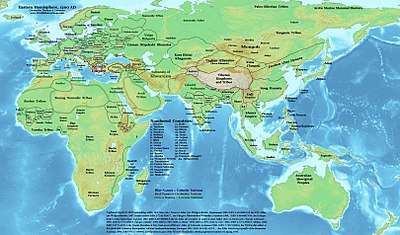 Eurasia on the eve of the Mongol invasions, c. 1200.
Eurasia on the eve of the Mongol invasions, c. 1200. Mongol invasion of Western Xia in 1209
Mongol invasion of Western Xia in 1209 Mongol invasion of the Jin dynasty (1211–1215)
Mongol invasion of the Jin dynasty (1211–1215) Genghis Khan's Central Asian campaigns (1216-1224)
Genghis Khan's Central Asian campaigns (1216-1224)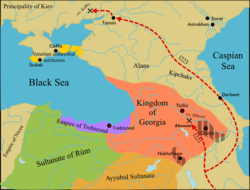 Mongol invasion of Georgia in 1221 and the Battle of the Kalka River in 1223
Mongol invasion of Georgia in 1221 and the Battle of the Kalka River in 1223 Mongol invasion of Western Xia, 1226-1227
Mongol invasion of Western Xia, 1226-1227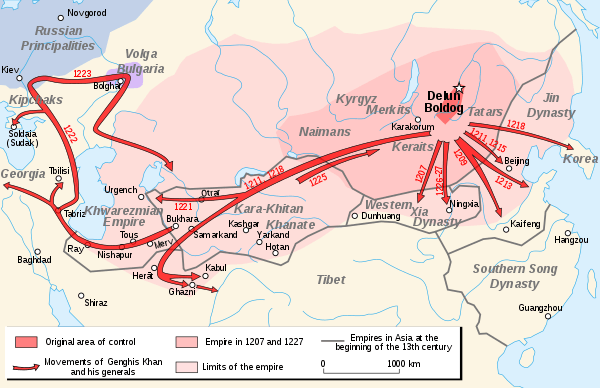 Mongol Empire in 1227 at Genghis' death
Mongol Empire in 1227 at Genghis' death Mongol conquest of the Jin dynasty (1230–1234)
Mongol conquest of the Jin dynasty (1230–1234)
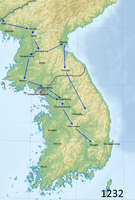 1232 Mongol invasion of Goryeo
1232 Mongol invasion of Goryeo 1235 Mongol invasion of Goryeo
1235 Mongol invasion of Goryeo Mongol invasion of Europe, 1236-1242
Mongol invasion of Europe, 1236-1242 Mongol invasion of Tibet in 1240
Mongol invasion of Tibet in 1240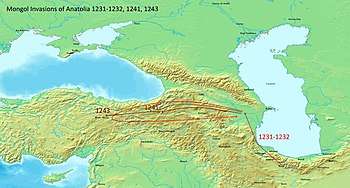 Mongol invasions of Anatolia, 1231, 1242
Mongol invasions of Anatolia, 1231, 1242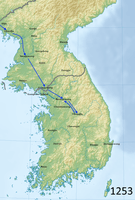 1253 Mongol invasion of Goryeo
1253 Mongol invasion of Goryeo Mongol invasion of the Middle East (1253-1260)
Mongol invasion of the Middle East (1253-1260) Mongol invasion of the Song dynasty (1234–79)
Mongol invasion of the Song dynasty (1234–79)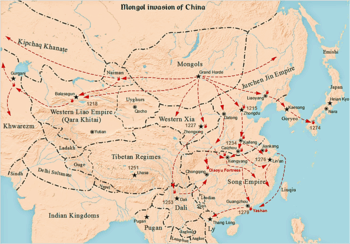 Mongol invasion of China (1205–1279)
Mongol invasion of China (1205–1279) The Mongol Empire, ca. 1300. The gray area is the later Timurid empire.
The Mongol Empire, ca. 1300. The gray area is the later Timurid empire.
See also
References
- Mote 2003, p. 403.
- Mote 2003, p. 415-416.
- Mote 2003, p. 419.
- Atwood 2004, p. 259.
- Sverdrup 2017, p. 42.
- Sverdrup 2017, p. 44.
- Twitchett 1994, p. 246.
- Sverdrup 2017, p. 47.
- Twitchett 1994, p. 251.
- Sinor 1990, p. 29.
- Mote 2003, p. 421.
- Atwood 2004, p. 425.
- Mote 2003, p. 422.
- Mote 2003, p. 424.
- Twitchett 1994, p. 206.
- Twitchett 1994, p. 343.
- Mote 2003, p. 254.
- Sinor 1990, p. 30.
- Twitchett 1994, p. 208.
- Atwood 2004, p. 445.
- Atwood 2004, p. 531.
- Atwood 2004, p. 81.
- Atwood 2004, p. 265.
- Atwood 2004, p. 224.
- Biran 2005, p. 75.
- Atwood 2004, p. 281.
- Atwood 2004, p. 416.
- Atwood 2004, p. 277.
- Atwood 2004, p. 620.
- Twitchett 1994, p. 415.
- Biran 2005, p. 83.
- Atwood 2004, p. 455.
- Atwood 2004, p. 393.
- Atwood 2004, p. 431.
- Atwood 2004, p. 591.
- Atwood 2004, p. 446.
- Atwood 2004, p. 319.
- Atwood 2004, p. 307.
- Twitchett 1994, p. 210.
- Atwood 2004, p. 308.
- Atwood 2004, p. 283.
- Atwood 2004, p. 121.
- Atwood 2004, p. 53.
- Twitchett 1994, p. 213.
- Atwood 2004, p. 100.
- Twitchett 1994, p. 367.
- Andrade 2016, p. 46.
- Atwood 2004, p. 32).
- Atwood 2004, p. 196.
- Twitchett 1994, p. 372.
- Twitchett 1994, p. 264.
- Atwood 2004, p. 418.
- Atwood 2004, p. 51.
- Atwood 2004, p. 479.
- Andrade 2016, p. 47.
- Atwod 2004, p. 479.
- Atwood 2004, p. 36.
- Atwood 2004, p. 538.
- Atwood 2004, p. 79.
- Twitchett 1994, p. 382.
- Atwood 2004, p. 73.
- Jackson 2005, p. 74.
- Atwood 2004, p. 82.
- Atwood 2004, p. 331.
- Atwood 2004, p. 323.
- Atwood 2004, p. 363.
- Twitchett 1994, p. 385.
- Atwood 2004, p. 83.
- Twitchett 1994, p. 389.
- Twitchett 1994, p. 392.
- Twitchett 1994, p. 394.
- Twitchett 1994, p. 405.
- Twitchett 1994, p. 463.
- Atwood 2004, p. 539.
- Twitchett 1994, p. 410.
- Twitchett 1994, p. 461.
- Twitchett 1994, p. 407.
- Twitchett 1994, p. 408.
- Twitchett 1994, p. 409.
- Atwood 2004, p. 37.
- Atwood 2004, p. 225.
- Jackson 2005, p. 116.
- Twitchett 1994, p. 418.
- Atwood 2004, p. 202.
- Atwood 2004, p. 28.
- Atwood 2004, p. 29.
- Twitchett 2009, p. 869.
- Atwood 2004, p. 320.
- Twitchett 2009, p. 870.
- Twitchett 2009, p. 410.
- Twitchett 1994, p. 411.
- Twitchett 1994, p. 422-423.
- Jackson 2005, p. 117.
- Twitchett 1994, p. 423.
- Atwood 2004, p. 6.
- Twitchett 1994, p. 412.
- Twitchett 1994, p. 431.
- Twitchett 1994, p. 460.
- Twitchett 1994, p. 449.
- Twitchett 1994, p. 426.
- Jackson 2005, p. 294.
- Twitchett 1994, p. 257.
- Atwood 2004, p. 226.
- Twitchett 1994, p. 447.
- Twitchett 1994, p. 474.
- Twitchett 1994, p. 452.
- Twitchett 1994, p. 462.
- Jackson 2005, p. 202.
- Atwood 2004, p. 234.
- Twitchett 1994, p. 443.
- Twitchett 1994, p. 454.
- Twitchett 1994, p. 458.
- Twitchett 1994, p. 459.
- Atwood 2004, p. 122.
- Twitchett 2009, p. 922.
- Twitchett 1994, p. 437.
- Twitchett 1994, p. 466.
- Atwood 2004, p. 231.
- Twitchett 1994, p. 451.
- Twitchett 1994, p. 457.
Bibliography
- Andrade, Tonio (2016), The Gunpowder Age: China, Military Innovation, and the Rise of the West in World History, Princeton University Press, ISBN 978-0-691-13597-7.
- Asimov, M.S. (1998), History of civilizations of Central Asia Volume IV The age of achievement: A.D. 750 to the end of the fifteenth century Part One The historical, social and economic setting, UNESCO Publishing
- Atwood, Christopher P. (2004), Encyclopedia of Mongolia and the Mongol Empire, Facts On File
- Barfield, Thomas (1989), The Perilous Frontier: Nomadic Empires and China, Basil Blackwell
- Barrett, Timothy Hugh (2008), The Woman Who Discovered Printing, Great Britain: Yale University Press, ISBN 978-0-300-12728-7 (alk. paper)
- Beckwith, Christopher I. (2009), Empires of the Silk Road: A History of Central Eurasia from the Bronze Age to the Present, Princeton University Press, ISBN 0-691-13589-4
- Beckwith, Christopher I (1987), The Tibetan Empire in Central Asia: A History of the Struggle for Great Power among Tibetans, Turks, Arabs, and Chinese during the Early Middle Ages, Princeton University Press
- Biran, Michal (2005), The Empire of the Qara Khitai in Eurasian History: Between China and the Islamic World, Cambridge Studies in Islamic Civilization, Cambridge, England: Cambridge University Press, ISBN 0521842263
- Bregel, Yuri (2003), An Historical Atlas of Central Asia, Brill
- Drompp, Michael Robert (2005), Tang China And The Collapse Of The Uighur Empire: A Documentary History, Brill
- Ebrey, Patricia Buckley (1999), The Cambridge Illustrated History of China, Cambridge: Cambridge University Press, ISBN 0-521-66991-X (paperback).
- Ebrey, Patricia Buckley; Walthall, Anne; Palais, James B. (2006), East Asia: A Cultural, Social, and Political History, Boston: Houghton Mifflin, ISBN 0-618-13384-4
- Golden, Peter B. (1992), An Introduction to the History of the Turkic Peoples: Ethnogenesis and State-Formation in Medieval and Early Modern Eurasia and the Middle East, OTTO HARRASSOWITZ · WIESBADEN
- Graff, David A. (2002), Medieval Chinese Warfare, 300-900, Warfare and History, London: Routledge, ISBN 0415239559
- Graff, David Andrew (2016), The Eurasian Way of War Military Practice in Seventh-Century China and Byzantium, Routledge, ISBN 978-0-415-46034-7.
- Haywood, John (1998), Historical Atlas of the Medieval World, AD 600-1492, Barnes & Noble
- Jackson, Peter (2005), The Mongols and the West, Pearson Education Limited
- Latourette, Kenneth Scott (1964), The Chinese, their history and culture, Volumes 1-2, Macmillan
- Lorge, Peter A. (2008), The Asian Military Revolution: from Gunpowder to the Bomb, Cambridge University Press, ISBN 978-0-521-60954-8
- Luttwak, Edward N. (2009), The Grand Strategy of the Byzantine Empire, The Belknap Press of Harvard University Press
- Millward, James (2009), Eurasian Crossroads: A History of Xinjiang, Columbia University Press
- Mote, F. W. (2003), Imperial China: 900–1800, Harvard University Press, ISBN 978-0674012127
- Needham, Joseph (1986), Science & Civilisation in China, V:7: The Gunpowder Epic, Cambridge University Press, ISBN 0-521-30358-3
- Rong, Xinjiang (2013), Eighteen Lectures on Dunhuang, Brill
- Schafer, Edward H. (1985), The Golden Peaches of Samarkand: A study of T'ang Exotics, University of California Press
- Shaban, M. A. (1979), The ʿAbbāsid Revolution, Cambridge: Cambridge University Press, ISBN 0-521-29534-3
- Sinor, Denis (1990), The Cambridge History of Early Inner Asia, Volume 1, Cambridge University Press
- Sima, Guang (2015), Bóyángbǎn Zīzhìtōngjiàn 54 huánghòu shīzōng 柏楊版資治通鑑54皇后失蹤, Yuǎnliú chūbǎnshìyè gǔfèn yǒuxiàn gōngsī, ISBN 957-32-0876-8
- Skaff, Jonathan Karam (2012), Sui-Tang China and Its Turko-Mongol Neighbors: Culture, Power, and Connections, 580-800 (Oxford Studies in Early Empires), Oxford University Press
- Standen, Naomi (2007), Unbounded Loyalty Frontier Crossings in Liao China, University of Hawai'i Press
- Steinhardt, Nancy Shatzman (1997), Liao Architecture, University of Hawaii Press
- Sverdrup, Carl Fredrik (2017), The Mongol Conquests: The Military Operations of Genghis Khan and Sube'etei, Helion & Company Limited
- Twitchett, Denis C. (1979), The Cambridge History of China, Vol. 3, Sui and T'ang China, 589–906, Cambridge University Press
- Twitchett, Denis (1994), "The Liao", The Cambridge History of China, Volume 6, Alien Regime and Border States, 907-1368, Cambridge: Cambridge University Press, pp. 43–153, ISBN 0521243319
- Twitchett, Denis (2009), The Cambridge History of China Volume 5 The Sung dynasty and its Predecessors, 907-1279, Cambridge University Press
- Wang, Zhenping (2013), Tang China in Multi-Polar Asia: A History of Diplomacy and War, University of Hawaii Press
- Wilkinson, Endymion (2015). Chinese History: A New Manual, 4th edition. Cambridge, MA: Harvard University Asia Center distributed by Harvard University Press. ISBN 9780674088467.CS1 maint: ref=harv (link)
- Xiong, Victor Cunrui (2000), Sui-Tang Chang'an: A Study in the Urban History of Late Medieval China (Michigan Monographs in Chinese Studies), U OF M CENTER FOR CHINESE STUDIES, ISBN 0892641371
- Xiong, Victor Cunrui (2009), Historical Dictionary of Medieval China, United States of America: Scarecrow Press, Inc., ISBN 0810860538
- Xu, Elina-Qian (2005), HISTORICAL DEVELOPMENT OF THE PRE-DYNASTIC KHITAN, Institute for Asian and African Studies 7
- Xue, Zongzheng (1992), Turkic peoples, 中国社会科学出版社
- Yuan, Shu (2001), Bóyángbǎn Tōngjiàn jìshìběnmò 28 dìèrcìhuànguánshídài 柏楊版通鑑記事本末28第二次宦官時代, Yuǎnliú chūbǎnshìyè gǔfèn yǒuxiàn gōngsī, ISBN 957-32-4273-7
- Yule, Henry (1915), Cathay and the Way Thither: Being a Collection of Medieval Notices of China, Vol I: Preliminary Essay on the Intercourse Between China and the Western Nations Previous to the Discovery of the Cape Route, Hakluyt Society
This article is issued from Wikipedia. The text is licensed under Creative Commons - Attribution - Sharealike. Additional terms may apply for the media files.